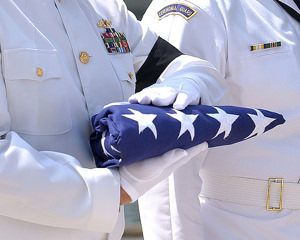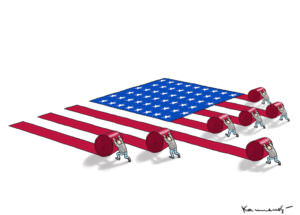The Best Stories on How We Treat Our Troops
This Memorial Day, we rounded up some of the best accountability journalism for U.S. soldiers in our recent wars.
By Blair Hickman, ProPublica
This collection originally appeared at ProPublica.
We rounded up some of the best accountability journalism for U.S. soldiers in our recent wars. Check them out while you’re basking on a boat this weekend, and remember the reason for this federal holiday.
Armored Humvees are in Short Supply, October 2003, News Observer When the insurgency in Iraq started, the U.S. Army didn’t have enough armored Humvees to protect its troops. As soldiers died in vehicles not built to withstand combat, the Army boosted their orders. But that takes time. While waiting for requests to be filled, soldiers rigged their own with sandbags.
Barrage of Bullets Drowned Out Cries of Comrades, The Washington Post, 2004 Part 1 and Part 2 After NFL-star-turned-soldier Pat Tillman died in Afghanistan, the Army took weeks to admit friendly fire had killed him. Over a year later, records emerged indicating they’d also withheld details of his death by fratricide, and the case spun into a saga of an investigation. When we asked national security expert Andrew Exum for a seminal piece on the case, he replied:

Contributed by @BradsNews
Behind The Walls of Ward 54, Salon, February 2005 Soldiers at Walter Reed said that the facility’s psychiatric care was outdated and inadequate — heavily medicating soldiers in “lockdown wards,” offering group therapy that often didn’t address wartime experiences, and in some cases, hesitating to diagnose PTSD at all.
Soldiers Face Neglect, Frustration, at Army’s Top Medical Facility, The Washington Post, February, 2007 The first article in a Pulitzer-Prize-winning investigation of neglect and bureaucratic failures at Walter Reed. While the surgical hospital was held up as a paragon of care, hundreds of soldiers went unnoticed in decrepit outpatient wards with few services or oversight. Soldiers described the experience as living in a chapter from Catch-22.
Arlington National Cemetery, Salon, 2009 Mismarked graves. Botched documentation. Unknown remains. Trashed personal mementos. In a yearlong investigation, Salon discovered grave errors at Arlington National Cemetery that pushed some families to extremes to make sure their loved ones were buried correctly — and that it was really them.
The Battle of Wanat, The Washington Post, October 2009 On July 13, 2008, nine U.S. soldiers were killed and 27 wounded in one of the bloodiest battles of the Afghan war. The attack provided a window into what went wrong in Afghanistan and prompted the Army to reassess its strategy. (Be sure to check out the on-the-ground videos in the timeline; they provide a very real peek into what it was like at this base.)
Restrepo, 2010 This Oscar-nominated documentary chronicles the year journalists Sebastian Junger and Tim Hetherington (who was killed last year in Libya) spent embedded with a U.S. Army platoon in Afghanistan, from deployment to battle and back home.
How Pricey For-Profit Colleges Target Vets’ GI Bill Money, Mother Jones, October 2011 As for-profit colleges swooped in to take advantage of the GI Bill’s generous education benefits, they often employed deceptive marketing techniques — in this case, websites that looked like official guides on how vets could maximize their education funds but were actually run by marketing firms for the schools.
Aftershock: The Blast That Shook Psycho Platoon, ProPublica and NPR March 2012 More than 115,000 soldiers have suffered mild traumatic brain injuries since the wars in Iraq and Afghanistan began. But our investigation with NPR found the military has failed to provide its returning soldiers with the care they need.
John Huston Film About WWII Soldiers that Army Suppressed Is Restored, The Washington Post, May 2012 A post-WWII documentary on the psychological effects of war has been hiding for nearly 60 years. The Army says it was because they wanted to protect the privacy of the soldiers; others say they wanted to preserve soldiers’ “warrior” image. Either way, the film has been restored, and as the Post notes, is “striking for its potential relevance for a new generation of veterans returning from Iraq and Afghanistan.”
Black Hawk Down, Philadelphia Inquirer, November 1997 This brutal, 15-hour battle in Somalia killed 18 elite U.S. soldiers, wounded 73, and changed the way America approached foreign intervention. Before it was a movie, or a book, Mark Bowden chronicled the soldiers’ ordeal in this brilliant account in the Philadelphia Inquirer.
Your support matters…Independent journalism is under threat and overshadowed by heavily funded mainstream media.
You can help level the playing field. Become a member.
Your tax-deductible contribution keeps us digging beneath the headlines to give you thought-provoking, investigative reporting and analysis that unearths what's really happening- without compromise.
Give today to support our courageous, independent journalists.





You need to be a supporter to comment.
There are currently no responses to this article.
Be the first to respond.